Report on Workforce Planning: Reflection and Development Plan
VerifiedAdded on 2023/06/12
|8
|2066
|482
Portfolio
AI Summary
This portfolio assignment provides a comprehensive exploration of workforce planning through three distinct components: a report, a reflective writing piece, and a personal development plan. The report delves into the intricacies of workforce planning, analyzing its impact on business performance and productivity, highlighting both the positive effects, such as improved employee retention and enhanced productivity, and the negative consequences of poor planning, including skill gaps and reduced employee engagement. The reflective writing section captures the author's learning journey, emphasizing the knowledge gained about workforce planning's role in organizational success and the importance of attracting and retaining skilled employees. Finally, the personal development plan outlines specific actions to enhance academic skills, communication abilities, and leadership qualities, with a focus on future career implications. The assignment concludes that effective workforce planning is crucial for organizational success, offering benefits like identifying skill gaps and ensuring employee satisfaction, while also acknowledging potential challenges that can affect business performance.
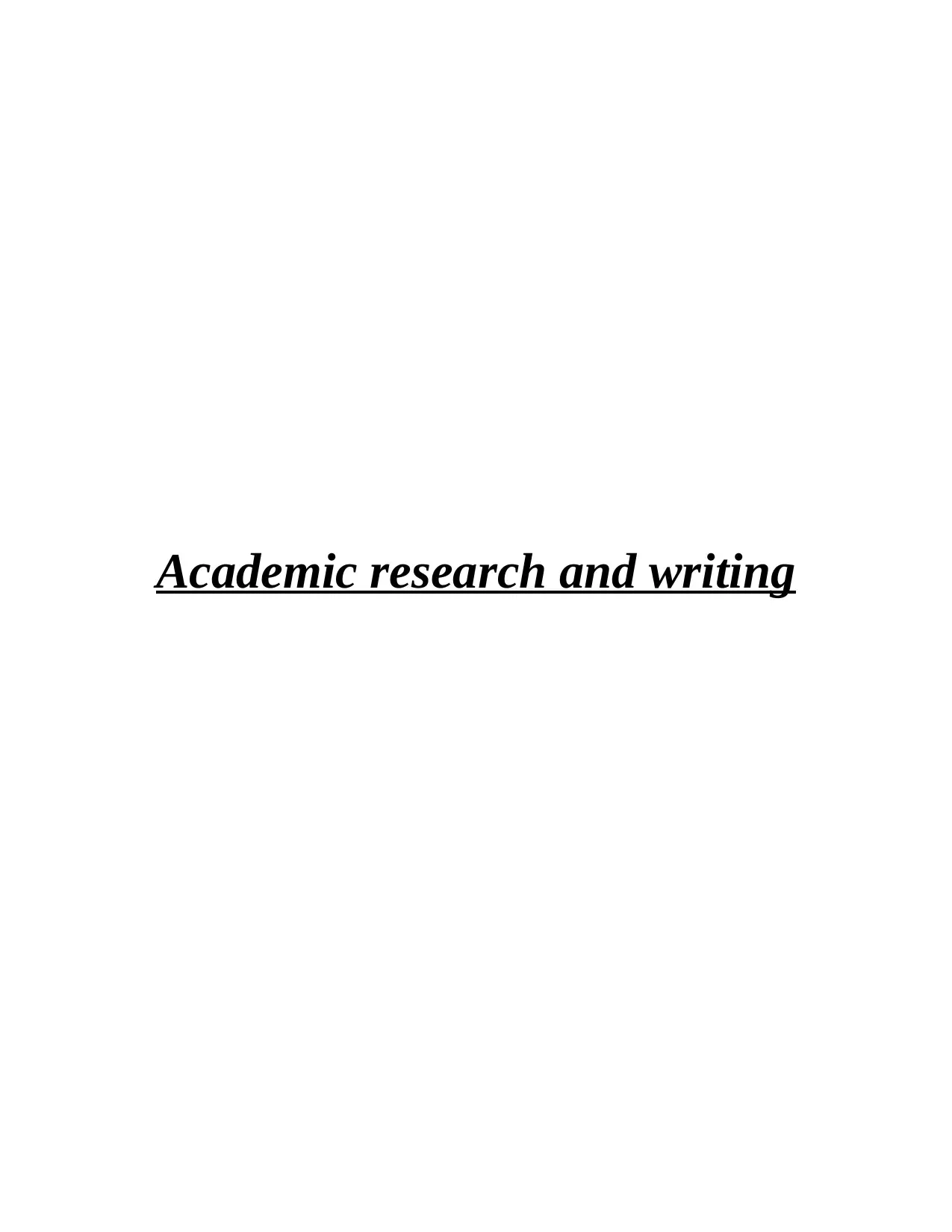
Academic research and writing
Paraphrase This Document
Need a fresh take? Get an instant paraphrase of this document with our AI Paraphraser
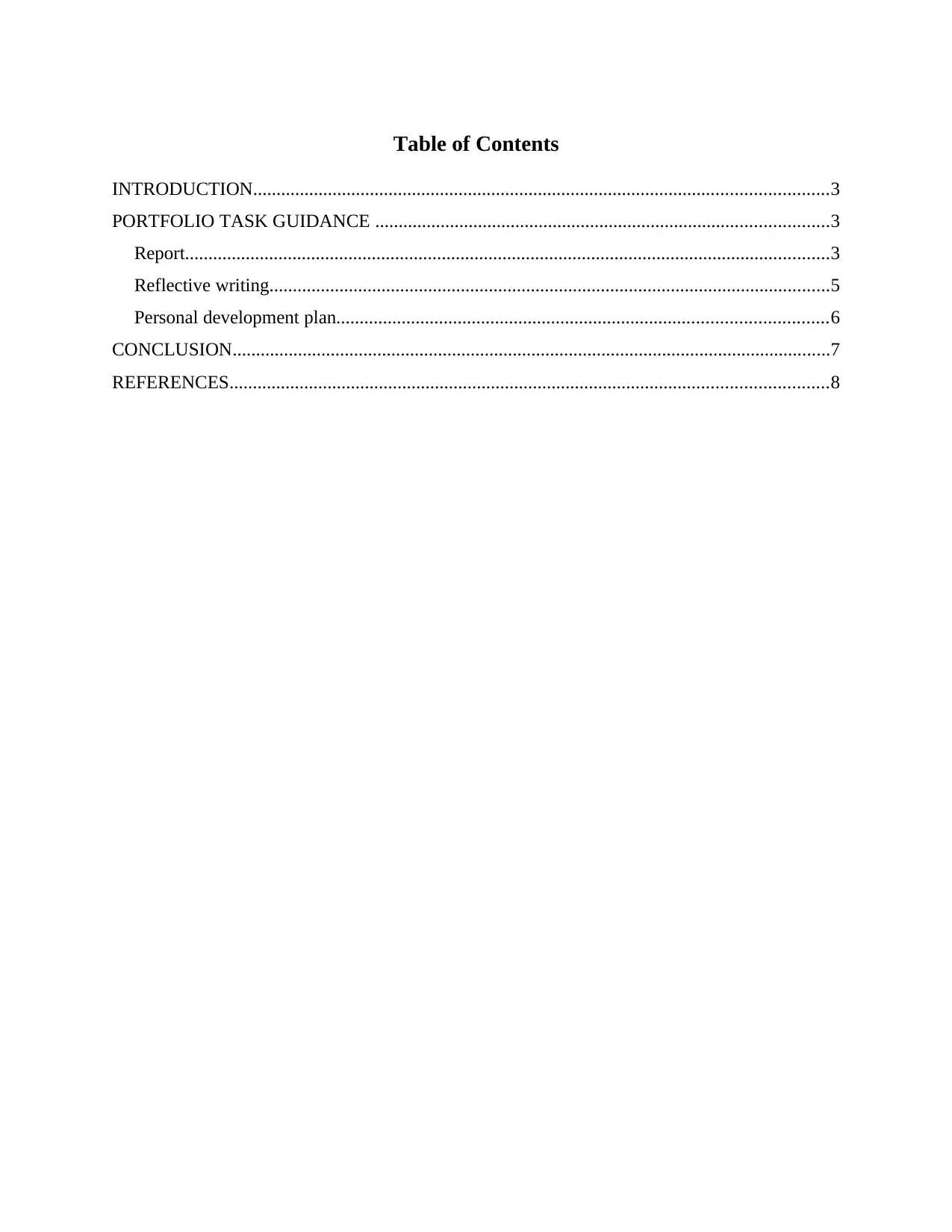
Table of Contents
INTRODUCTION...........................................................................................................................3
PORTFOLIO TASK GUIDANCE .................................................................................................3
Report..........................................................................................................................................3
Reflective writing........................................................................................................................5
Personal development plan.........................................................................................................6
CONCLUSION................................................................................................................................7
REFERENCES................................................................................................................................8
INTRODUCTION...........................................................................................................................3
PORTFOLIO TASK GUIDANCE .................................................................................................3
Report..........................................................................................................................................3
Reflective writing........................................................................................................................5
Personal development plan.........................................................................................................6
CONCLUSION................................................................................................................................7
REFERENCES................................................................................................................................8
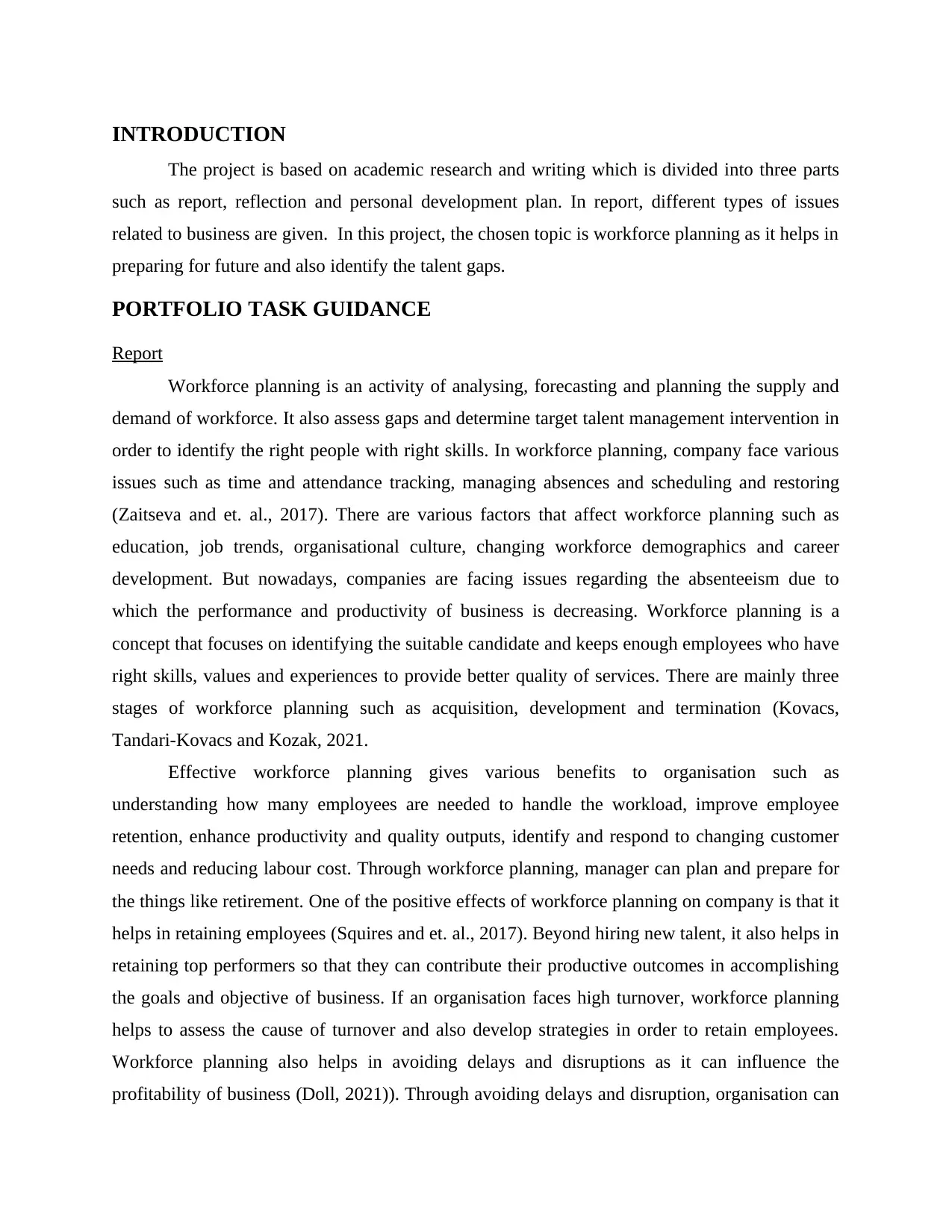
INTRODUCTION
The project is based on academic research and writing which is divided into three parts
such as report, reflection and personal development plan. In report, different types of issues
related to business are given. In this project, the chosen topic is workforce planning as it helps in
preparing for future and also identify the talent gaps.
PORTFOLIO TASK GUIDANCE
Report
Workforce planning is an activity of analysing, forecasting and planning the supply and
demand of workforce. It also assess gaps and determine target talent management intervention in
order to identify the right people with right skills. In workforce planning, company face various
issues such as time and attendance tracking, managing absences and scheduling and restoring
(Zaitseva and et. al., 2017). There are various factors that affect workforce planning such as
education, job trends, organisational culture, changing workforce demographics and career
development. But nowadays, companies are facing issues regarding the absenteeism due to
which the performance and productivity of business is decreasing. Workforce planning is a
concept that focuses on identifying the suitable candidate and keeps enough employees who have
right skills, values and experiences to provide better quality of services. There are mainly three
stages of workforce planning such as acquisition, development and termination (Kovacs,
Tandari-Kovacs and Kozak, 2021.
Effective workforce planning gives various benefits to organisation such as
understanding how many employees are needed to handle the workload, improve employee
retention, enhance productivity and quality outputs, identify and respond to changing customer
needs and reducing labour cost. Through workforce planning, manager can plan and prepare for
the things like retirement. One of the positive effects of workforce planning on company is that it
helps in retaining employees (Squires and et. al., 2017). Beyond hiring new talent, it also helps in
retaining top performers so that they can contribute their productive outcomes in accomplishing
the goals and objective of business. If an organisation faces high turnover, workforce planning
helps to assess the cause of turnover and also develop strategies in order to retain employees.
Workforce planning also helps in avoiding delays and disruptions as it can influence the
profitability of business (Doll, 2021)). Through avoiding delays and disruption, organisation can
The project is based on academic research and writing which is divided into three parts
such as report, reflection and personal development plan. In report, different types of issues
related to business are given. In this project, the chosen topic is workforce planning as it helps in
preparing for future and also identify the talent gaps.
PORTFOLIO TASK GUIDANCE
Report
Workforce planning is an activity of analysing, forecasting and planning the supply and
demand of workforce. It also assess gaps and determine target talent management intervention in
order to identify the right people with right skills. In workforce planning, company face various
issues such as time and attendance tracking, managing absences and scheduling and restoring
(Zaitseva and et. al., 2017). There are various factors that affect workforce planning such as
education, job trends, organisational culture, changing workforce demographics and career
development. But nowadays, companies are facing issues regarding the absenteeism due to
which the performance and productivity of business is decreasing. Workforce planning is a
concept that focuses on identifying the suitable candidate and keeps enough employees who have
right skills, values and experiences to provide better quality of services. There are mainly three
stages of workforce planning such as acquisition, development and termination (Kovacs,
Tandari-Kovacs and Kozak, 2021.
Effective workforce planning gives various benefits to organisation such as
understanding how many employees are needed to handle the workload, improve employee
retention, enhance productivity and quality outputs, identify and respond to changing customer
needs and reducing labour cost. Through workforce planning, manager can plan and prepare for
the things like retirement. One of the positive effects of workforce planning on company is that it
helps in retaining employees (Squires and et. al., 2017). Beyond hiring new talent, it also helps in
retaining top performers so that they can contribute their productive outcomes in accomplishing
the goals and objective of business. If an organisation faces high turnover, workforce planning
helps to assess the cause of turnover and also develop strategies in order to retain employees.
Workforce planning also helps in avoiding delays and disruptions as it can influence the
profitability of business (Doll, 2021)). Through avoiding delays and disruption, organisation can
⊘ This is a preview!⊘
Do you want full access?
Subscribe today to unlock all pages.

Trusted by 1+ million students worldwide
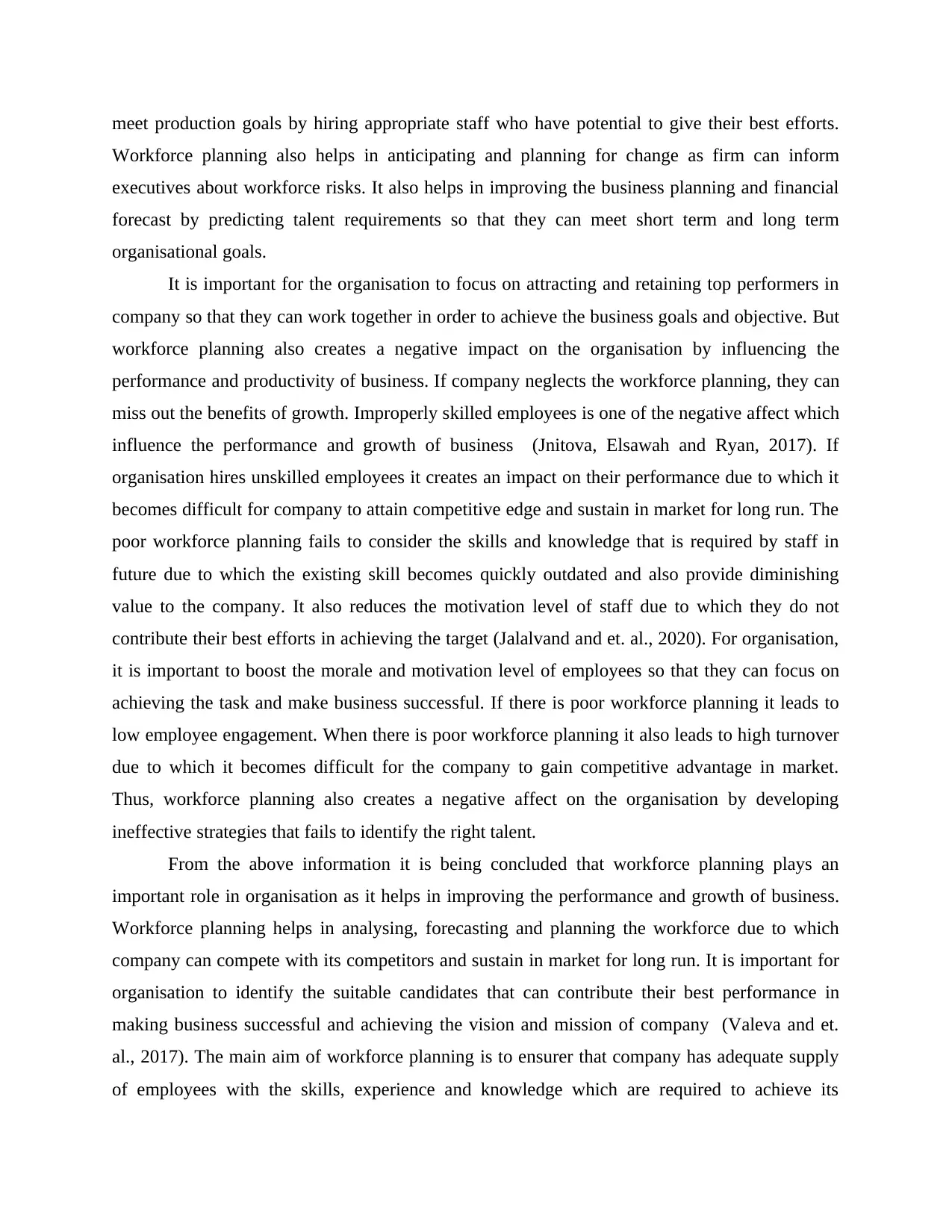
meet production goals by hiring appropriate staff who have potential to give their best efforts.
Workforce planning also helps in anticipating and planning for change as firm can inform
executives about workforce risks. It also helps in improving the business planning and financial
forecast by predicting talent requirements so that they can meet short term and long term
organisational goals.
It is important for the organisation to focus on attracting and retaining top performers in
company so that they can work together in order to achieve the business goals and objective. But
workforce planning also creates a negative impact on the organisation by influencing the
performance and productivity of business. If company neglects the workforce planning, they can
miss out the benefits of growth. Improperly skilled employees is one of the negative affect which
influence the performance and growth of business (Jnitova, Elsawah and Ryan, 2017). If
organisation hires unskilled employees it creates an impact on their performance due to which it
becomes difficult for company to attain competitive edge and sustain in market for long run. The
poor workforce planning fails to consider the skills and knowledge that is required by staff in
future due to which the existing skill becomes quickly outdated and also provide diminishing
value to the company. It also reduces the motivation level of staff due to which they do not
contribute their best efforts in achieving the target (Jalalvand and et. al., 2020). For organisation,
it is important to boost the morale and motivation level of employees so that they can focus on
achieving the task and make business successful. If there is poor workforce planning it leads to
low employee engagement. When there is poor workforce planning it also leads to high turnover
due to which it becomes difficult for the company to gain competitive advantage in market.
Thus, workforce planning also creates a negative affect on the organisation by developing
ineffective strategies that fails to identify the right talent.
From the above information it is being concluded that workforce planning plays an
important role in organisation as it helps in improving the performance and growth of business.
Workforce planning helps in analysing, forecasting and planning the workforce due to which
company can compete with its competitors and sustain in market for long run. It is important for
organisation to identify the suitable candidates that can contribute their best performance in
making business successful and achieving the vision and mission of company (Valeva and et.
al., 2017). The main aim of workforce planning is to ensurer that company has adequate supply
of employees with the skills, experience and knowledge which are required to achieve its
Workforce planning also helps in anticipating and planning for change as firm can inform
executives about workforce risks. It also helps in improving the business planning and financial
forecast by predicting talent requirements so that they can meet short term and long term
organisational goals.
It is important for the organisation to focus on attracting and retaining top performers in
company so that they can work together in order to achieve the business goals and objective. But
workforce planning also creates a negative impact on the organisation by influencing the
performance and productivity of business. If company neglects the workforce planning, they can
miss out the benefits of growth. Improperly skilled employees is one of the negative affect which
influence the performance and growth of business (Jnitova, Elsawah and Ryan, 2017). If
organisation hires unskilled employees it creates an impact on their performance due to which it
becomes difficult for company to attain competitive edge and sustain in market for long run. The
poor workforce planning fails to consider the skills and knowledge that is required by staff in
future due to which the existing skill becomes quickly outdated and also provide diminishing
value to the company. It also reduces the motivation level of staff due to which they do not
contribute their best efforts in achieving the target (Jalalvand and et. al., 2020). For organisation,
it is important to boost the morale and motivation level of employees so that they can focus on
achieving the task and make business successful. If there is poor workforce planning it leads to
low employee engagement. When there is poor workforce planning it also leads to high turnover
due to which it becomes difficult for the company to gain competitive advantage in market.
Thus, workforce planning also creates a negative affect on the organisation by developing
ineffective strategies that fails to identify the right talent.
From the above information it is being concluded that workforce planning plays an
important role in organisation as it helps in improving the performance and growth of business.
Workforce planning helps in analysing, forecasting and planning the workforce due to which
company can compete with its competitors and sustain in market for long run. It is important for
organisation to identify the suitable candidates that can contribute their best performance in
making business successful and achieving the vision and mission of company (Valeva and et.
al., 2017). The main aim of workforce planning is to ensurer that company has adequate supply
of employees with the skills, experience and knowledge which are required to achieve its
Paraphrase This Document
Need a fresh take? Get an instant paraphrase of this document with our AI Paraphraser
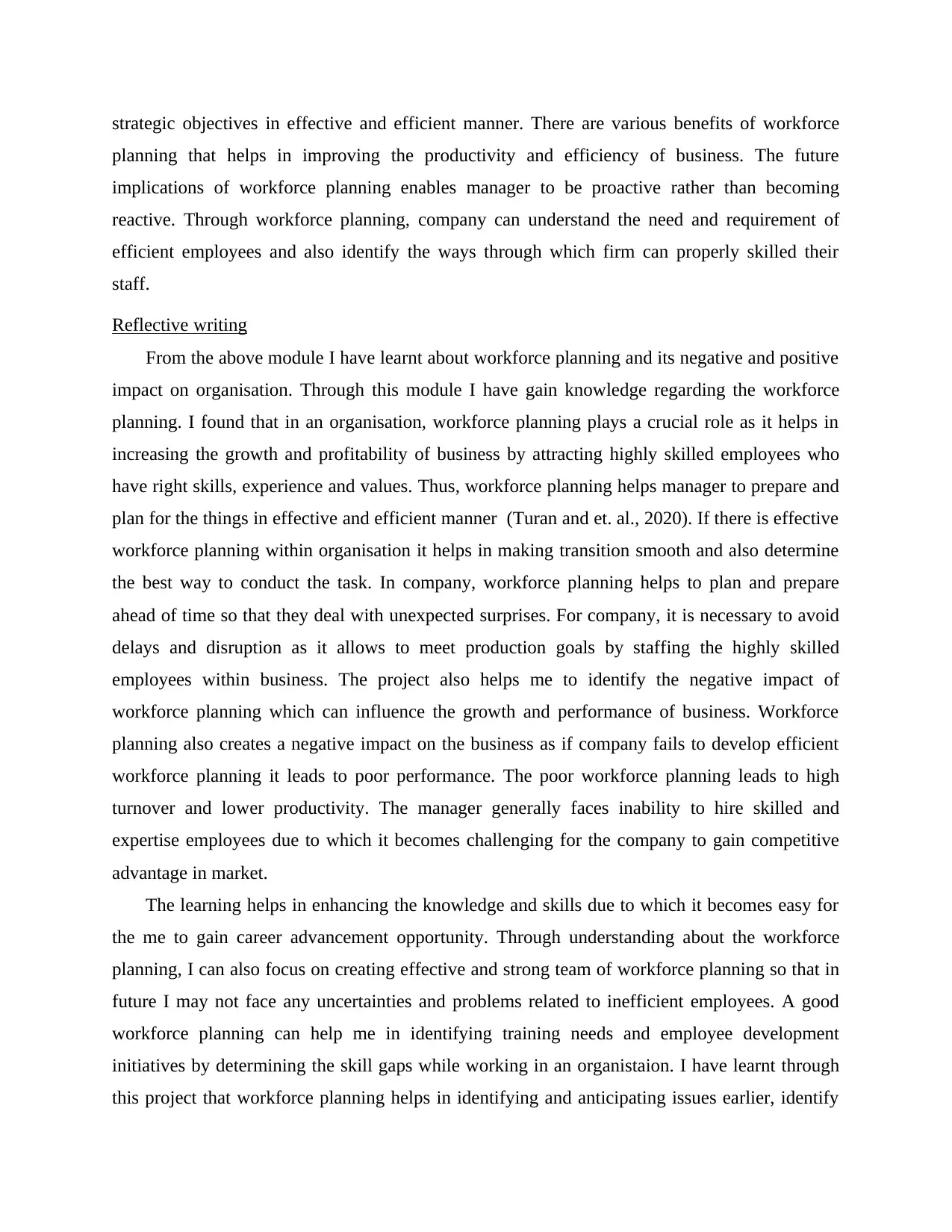
strategic objectives in effective and efficient manner. There are various benefits of workforce
planning that helps in improving the productivity and efficiency of business. The future
implications of workforce planning enables manager to be proactive rather than becoming
reactive. Through workforce planning, company can understand the need and requirement of
efficient employees and also identify the ways through which firm can properly skilled their
staff.
Reflective writing
From the above module I have learnt about workforce planning and its negative and positive
impact on organisation. Through this module I have gain knowledge regarding the workforce
planning. I found that in an organisation, workforce planning plays a crucial role as it helps in
increasing the growth and profitability of business by attracting highly skilled employees who
have right skills, experience and values. Thus, workforce planning helps manager to prepare and
plan for the things in effective and efficient manner (Turan and et. al., 2020). If there is effective
workforce planning within organisation it helps in making transition smooth and also determine
the best way to conduct the task. In company, workforce planning helps to plan and prepare
ahead of time so that they deal with unexpected surprises. For company, it is necessary to avoid
delays and disruption as it allows to meet production goals by staffing the highly skilled
employees within business. The project also helps me to identify the negative impact of
workforce planning which can influence the growth and performance of business. Workforce
planning also creates a negative impact on the business as if company fails to develop efficient
workforce planning it leads to poor performance. The poor workforce planning leads to high
turnover and lower productivity. The manager generally faces inability to hire skilled and
expertise employees due to which it becomes challenging for the company to gain competitive
advantage in market.
The learning helps in enhancing the knowledge and skills due to which it becomes easy for
the me to gain career advancement opportunity. Through understanding about the workforce
planning, I can also focus on creating effective and strong team of workforce planning so that in
future I may not face any uncertainties and problems related to inefficient employees. A good
workforce planning can help me in identifying training needs and employee development
initiatives by determining the skill gaps while working in an organistaion. I have learnt through
this project that workforce planning helps in identifying and anticipating issues earlier, identify
planning that helps in improving the productivity and efficiency of business. The future
implications of workforce planning enables manager to be proactive rather than becoming
reactive. Through workforce planning, company can understand the need and requirement of
efficient employees and also identify the ways through which firm can properly skilled their
staff.
Reflective writing
From the above module I have learnt about workforce planning and its negative and positive
impact on organisation. Through this module I have gain knowledge regarding the workforce
planning. I found that in an organisation, workforce planning plays a crucial role as it helps in
increasing the growth and profitability of business by attracting highly skilled employees who
have right skills, experience and values. Thus, workforce planning helps manager to prepare and
plan for the things in effective and efficient manner (Turan and et. al., 2020). If there is effective
workforce planning within organisation it helps in making transition smooth and also determine
the best way to conduct the task. In company, workforce planning helps to plan and prepare
ahead of time so that they deal with unexpected surprises. For company, it is necessary to avoid
delays and disruption as it allows to meet production goals by staffing the highly skilled
employees within business. The project also helps me to identify the negative impact of
workforce planning which can influence the growth and performance of business. Workforce
planning also creates a negative impact on the business as if company fails to develop efficient
workforce planning it leads to poor performance. The poor workforce planning leads to high
turnover and lower productivity. The manager generally faces inability to hire skilled and
expertise employees due to which it becomes challenging for the company to gain competitive
advantage in market.
The learning helps in enhancing the knowledge and skills due to which it becomes easy for
the me to gain career advancement opportunity. Through understanding about the workforce
planning, I can also focus on creating effective and strong team of workforce planning so that in
future I may not face any uncertainties and problems related to inefficient employees. A good
workforce planning can help me in identifying training needs and employee development
initiatives by determining the skill gaps while working in an organistaion. I have learnt through
this project that workforce planning helps in identifying and anticipating issues earlier, identify
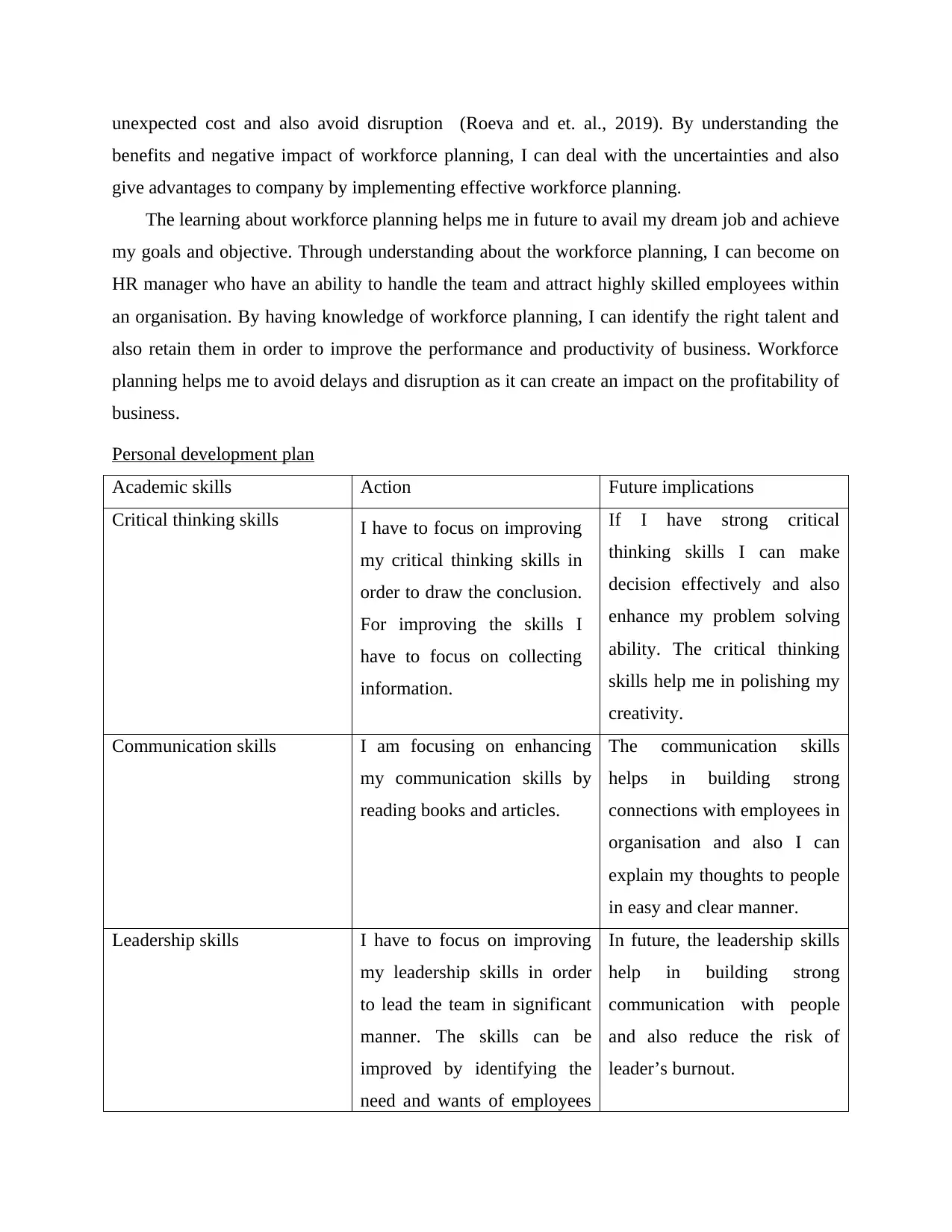
unexpected cost and also avoid disruption (Roeva and et. al., 2019). By understanding the
benefits and negative impact of workforce planning, I can deal with the uncertainties and also
give advantages to company by implementing effective workforce planning.
The learning about workforce planning helps me in future to avail my dream job and achieve
my goals and objective. Through understanding about the workforce planning, I can become on
HR manager who have an ability to handle the team and attract highly skilled employees within
an organisation. By having knowledge of workforce planning, I can identify the right talent and
also retain them in order to improve the performance and productivity of business. Workforce
planning helps me to avoid delays and disruption as it can create an impact on the profitability of
business.
Personal development plan
Academic skills Action Future implications
Critical thinking skills I have to focus on improving
my critical thinking skills in
order to draw the conclusion.
For improving the skills I
have to focus on collecting
information.
If I have strong critical
thinking skills I can make
decision effectively and also
enhance my problem solving
ability. The critical thinking
skills help me in polishing my
creativity.
Communication skills I am focusing on enhancing
my communication skills by
reading books and articles.
The communication skills
helps in building strong
connections with employees in
organisation and also I can
explain my thoughts to people
in easy and clear manner.
Leadership skills I have to focus on improving
my leadership skills in order
to lead the team in significant
manner. The skills can be
improved by identifying the
need and wants of employees
In future, the leadership skills
help in building strong
communication with people
and also reduce the risk of
leader’s burnout.
benefits and negative impact of workforce planning, I can deal with the uncertainties and also
give advantages to company by implementing effective workforce planning.
The learning about workforce planning helps me in future to avail my dream job and achieve
my goals and objective. Through understanding about the workforce planning, I can become on
HR manager who have an ability to handle the team and attract highly skilled employees within
an organisation. By having knowledge of workforce planning, I can identify the right talent and
also retain them in order to improve the performance and productivity of business. Workforce
planning helps me to avoid delays and disruption as it can create an impact on the profitability of
business.
Personal development plan
Academic skills Action Future implications
Critical thinking skills I have to focus on improving
my critical thinking skills in
order to draw the conclusion.
For improving the skills I
have to focus on collecting
information.
If I have strong critical
thinking skills I can make
decision effectively and also
enhance my problem solving
ability. The critical thinking
skills help me in polishing my
creativity.
Communication skills I am focusing on enhancing
my communication skills by
reading books and articles.
The communication skills
helps in building strong
connections with employees in
organisation and also I can
explain my thoughts to people
in easy and clear manner.
Leadership skills I have to focus on improving
my leadership skills in order
to lead the team in significant
manner. The skills can be
improved by identifying the
need and wants of employees
In future, the leadership skills
help in building strong
communication with people
and also reduce the risk of
leader’s burnout.
⊘ This is a preview!⊘
Do you want full access?
Subscribe today to unlock all pages.

Trusted by 1+ million students worldwide
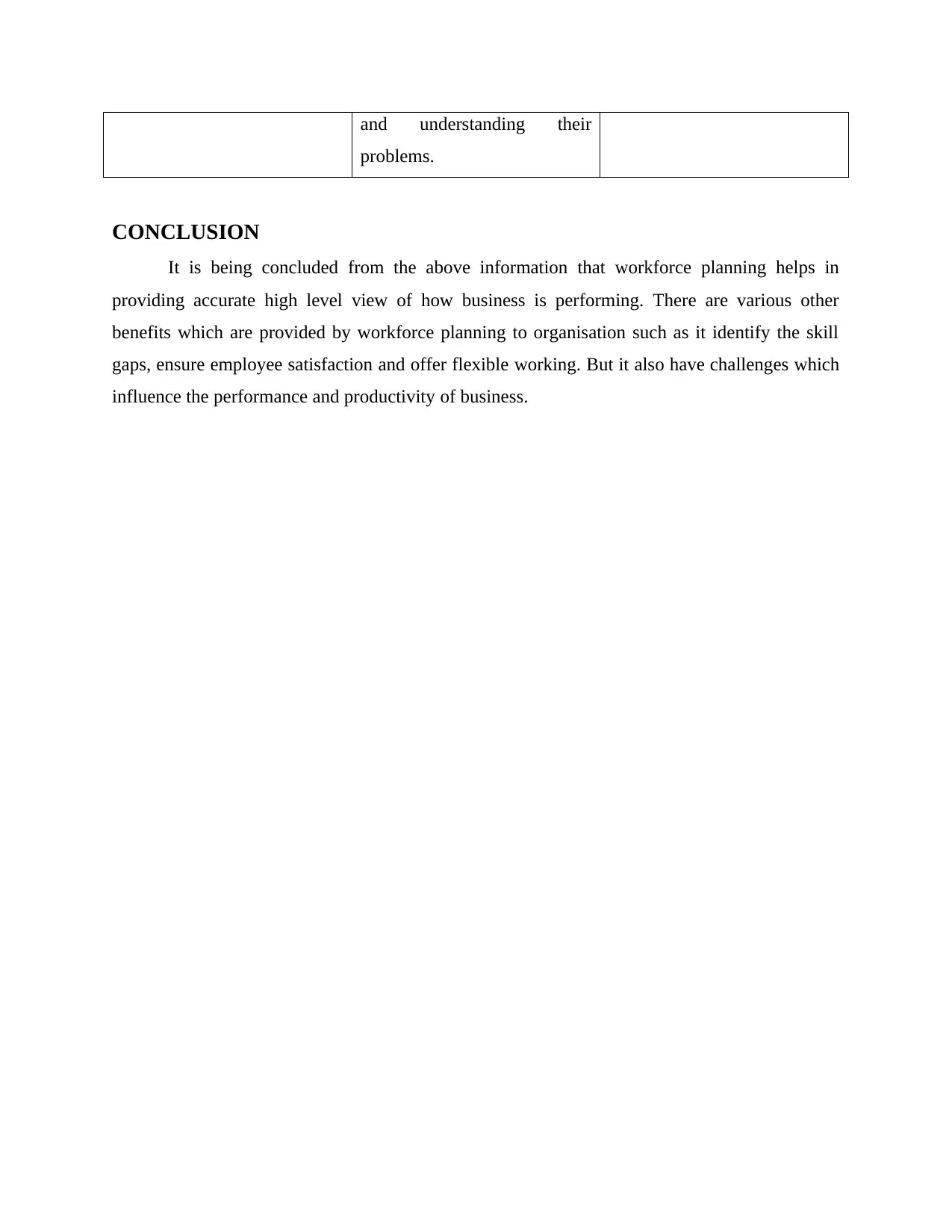
and understanding their
problems.
CONCLUSION
It is being concluded from the above information that workforce planning helps in
providing accurate high level view of how business is performing. There are various other
benefits which are provided by workforce planning to organisation such as it identify the skill
gaps, ensure employee satisfaction and offer flexible working. But it also have challenges which
influence the performance and productivity of business.
problems.
CONCLUSION
It is being concluded from the above information that workforce planning helps in
providing accurate high level view of how business is performing. There are various other
benefits which are provided by workforce planning to organisation such as it identify the skill
gaps, ensure employee satisfaction and offer flexible working. But it also have challenges which
influence the performance and productivity of business.
Paraphrase This Document
Need a fresh take? Get an instant paraphrase of this document with our AI Paraphraser
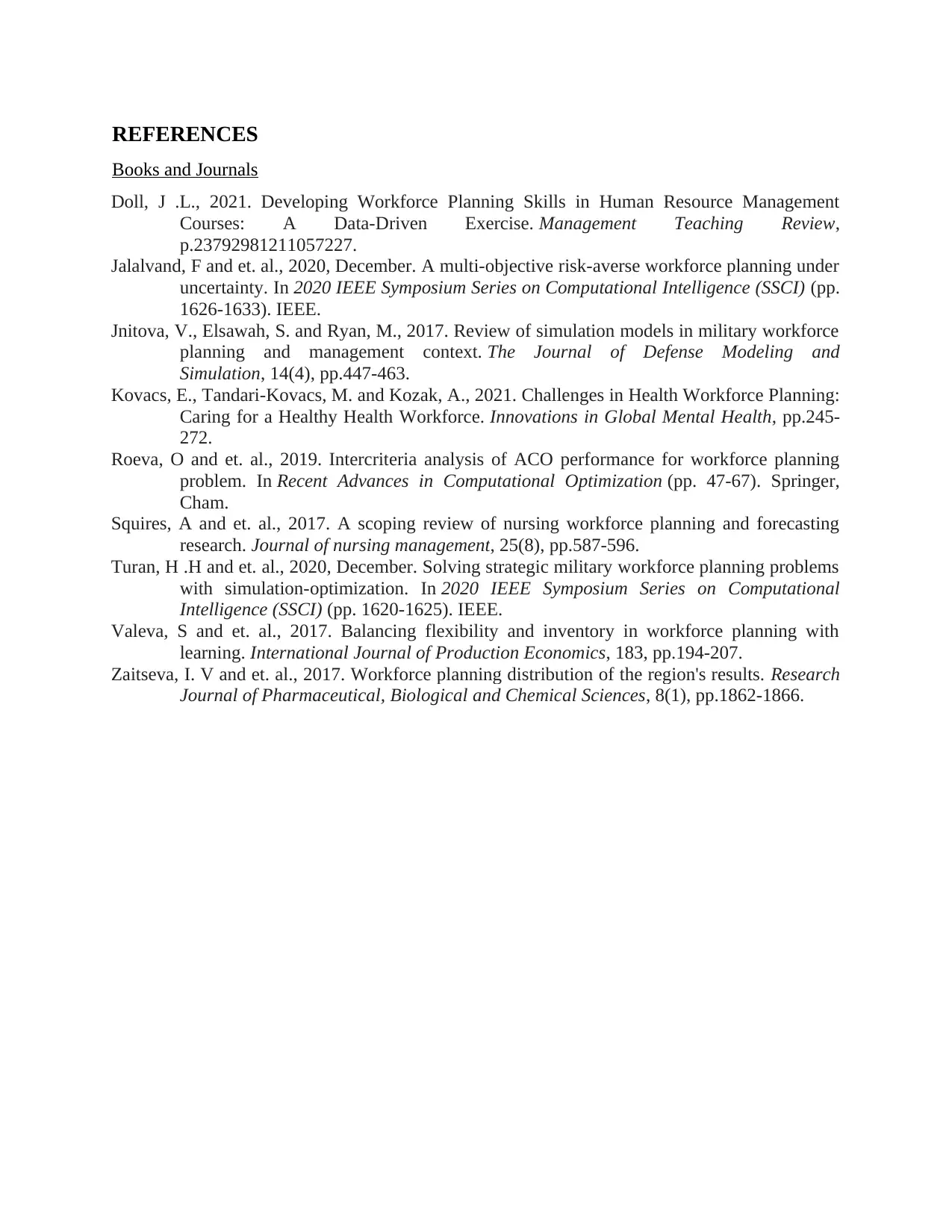
REFERENCES
Books and Journals
Doll, J .L., 2021. Developing Workforce Planning Skills in Human Resource Management
Courses: A Data-Driven Exercise. Management Teaching Review,
p.23792981211057227.
Jalalvand, F and et. al., 2020, December. A multi-objective risk-averse workforce planning under
uncertainty. In 2020 IEEE Symposium Series on Computational Intelligence (SSCI) (pp.
1626-1633). IEEE.
Jnitova, V., Elsawah, S. and Ryan, M., 2017. Review of simulation models in military workforce
planning and management context. The Journal of Defense Modeling and
Simulation, 14(4), pp.447-463.
Kovacs, E., Tandari-Kovacs, M. and Kozak, A., 2021. Challenges in Health Workforce Planning:
Caring for a Healthy Health Workforce. Innovations in Global Mental Health, pp.245-
272.
Roeva, O and et. al., 2019. Intercriteria analysis of ACO performance for workforce planning
problem. In Recent Advances in Computational Optimization (pp. 47-67). Springer,
Cham.
Squires, A and et. al., 2017. A scoping review of nursing workforce planning and forecasting
research. Journal of nursing management, 25(8), pp.587-596.
Turan, H .H and et. al., 2020, December. Solving strategic military workforce planning problems
with simulation-optimization. In 2020 IEEE Symposium Series on Computational
Intelligence (SSCI) (pp. 1620-1625). IEEE.
Valeva, S and et. al., 2017. Balancing flexibility and inventory in workforce planning with
learning. International Journal of Production Economics, 183, pp.194-207.
Zaitseva, I. V and et. al., 2017. Workforce planning distribution of the region's results. Research
Journal of Pharmaceutical, Biological and Chemical Sciences, 8(1), pp.1862-1866.
Books and Journals
Doll, J .L., 2021. Developing Workforce Planning Skills in Human Resource Management
Courses: A Data-Driven Exercise. Management Teaching Review,
p.23792981211057227.
Jalalvand, F and et. al., 2020, December. A multi-objective risk-averse workforce planning under
uncertainty. In 2020 IEEE Symposium Series on Computational Intelligence (SSCI) (pp.
1626-1633). IEEE.
Jnitova, V., Elsawah, S. and Ryan, M., 2017. Review of simulation models in military workforce
planning and management context. The Journal of Defense Modeling and
Simulation, 14(4), pp.447-463.
Kovacs, E., Tandari-Kovacs, M. and Kozak, A., 2021. Challenges in Health Workforce Planning:
Caring for a Healthy Health Workforce. Innovations in Global Mental Health, pp.245-
272.
Roeva, O and et. al., 2019. Intercriteria analysis of ACO performance for workforce planning
problem. In Recent Advances in Computational Optimization (pp. 47-67). Springer,
Cham.
Squires, A and et. al., 2017. A scoping review of nursing workforce planning and forecasting
research. Journal of nursing management, 25(8), pp.587-596.
Turan, H .H and et. al., 2020, December. Solving strategic military workforce planning problems
with simulation-optimization. In 2020 IEEE Symposium Series on Computational
Intelligence (SSCI) (pp. 1620-1625). IEEE.
Valeva, S and et. al., 2017. Balancing flexibility and inventory in workforce planning with
learning. International Journal of Production Economics, 183, pp.194-207.
Zaitseva, I. V and et. al., 2017. Workforce planning distribution of the region's results. Research
Journal of Pharmaceutical, Biological and Chemical Sciences, 8(1), pp.1862-1866.
1 out of 8
Related Documents
Your All-in-One AI-Powered Toolkit for Academic Success.
+13062052269
info@desklib.com
Available 24*7 on WhatsApp / Email
![[object Object]](/_next/static/media/star-bottom.7253800d.svg)
Unlock your academic potential
Copyright © 2020–2025 A2Z Services. All Rights Reserved. Developed and managed by ZUCOL.





